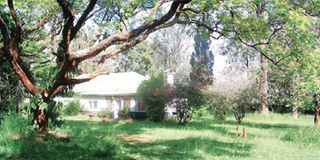Kicheche Valley Camp

What you need to know:
- The jackals and the dik diks keep in full sight of the leopard, alerting the others that the predator is on the prowly. . .
The silver-backed jackal yelps. He is alert, keeps darting to and fro across the grassy plain by a dry riverbed.
The yelps intensify and a tiny dik dik joins the fray with short sharp calls. It is unusual to hear these small creatures of the savanna making so much noise. There is an inexplicable intensity in the air.
“Perhaps it’s a cat,” whispers Jonathan ole Kaelo as he follows the jackal slowly, all the time keeping his distance.
Then, without any warning, the leopard reveals herself from the scrub. She takes us by surprise. Being alone in the presence of one of the most elusive cats on the planet is special.
The jackals and the dik diks keep in full sight of her, alerting the others that the predator is on the prowl. The birds join in the fray. The she-leopard knows there is little she can do now and has a little wander-around before flopping down on the grass by a log.
There is no point in a chase for the nimble-footed creatures will outwit her. “She has a pair of nearly full-grown cubs who are ready to leave their mother’s side,” informs ole Kaleo.
“The animals prefer to be in sight of her,” ole Kaelo continues, “so that she knows she’s been seen.” The young guide was trained at the Koyaki Guiding School in the conservancy which set the precedent for creating conservancies.
Sound-filled drama
An hour passes with the nimble-footed creatures on high alert, watching the leopard. It is also unusual to be alone with a leopard for such a period of time. In the more famous parks and reserves, this powerful predator is swamped by cars.
Just as amazing as watching the sound-filled drama of the predator and the prey, is the story of Mara Naboisho Conservancy. Bordering the more famous Maasai Mara National Reserve, this land belonging to the Maasai landowners was formally opened as a conservancy in 2010, adding 50,000 acres to the Mara ecosystem.
Since then there has been no looking back as the conservancy boasts the highest concentration of wildlife in the greater Mara ecosystem.
Ole Kaelo has funny anecdotes up his sleeve — or rather shuka (the Maasai toga). “That giraffe is pretending to be a tree,” he jokes as the tall male giraffe stands statuesque-still and the rest of the tower continues to browse. “Mount Kilimanjaro is almost a thousand giraffes high.”
“In Naboisho, we have the highest density of giraffes, Coke’s hartebeest, and impalas,” says Mika ole Kaleko, ole Kaelo’s colleague. Both are also members of the conservancy. “Before the Naboisho conservancy was formed, nobody ever thought that the area could flourish as a tourism and wildlife destination.
“The Maasai Mara National Reserve cannot hold all the wildlife. It is just a minor section of the greater Mara. By creating conservancies, we’re opening up land for the wildlife and earning from them.”
To complement the conservancy is the exquisite camp in the chasm of the valley. Innocuous in the vastness of the land, the path leads down to the canvas camp that boasts only six tents — or rather boudoirs — and when l step into mine, l want to live in it.
Sitting on a wooden deck with a verandah, it opens on three sides to the most stunning views — and uninterrupted — of the valley and the wild animals walking through. A chandelier hangs from the silk-cast ceiling and you could be the only person on earth.
“We emphasise quality, not quantity,” states ole Kaleko.




